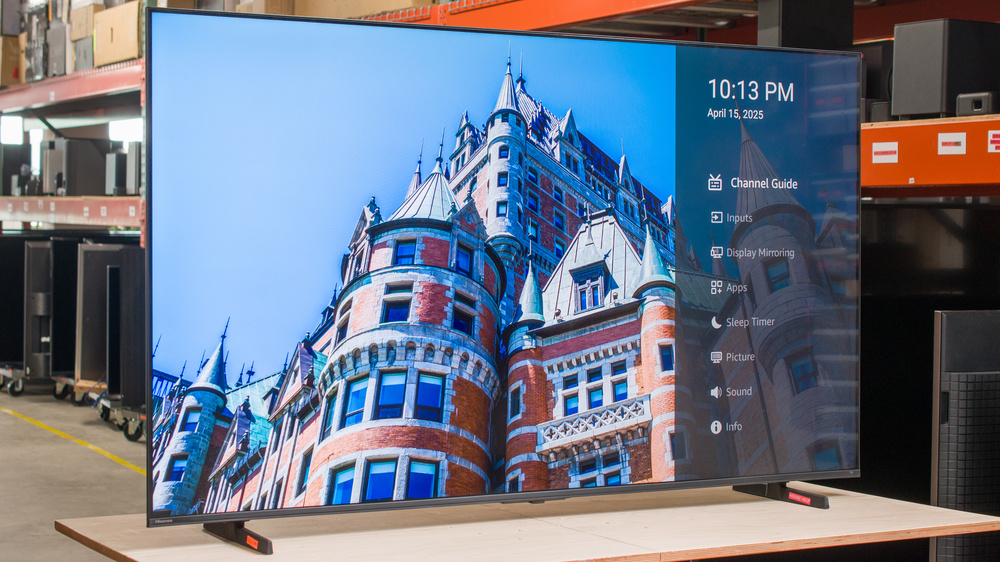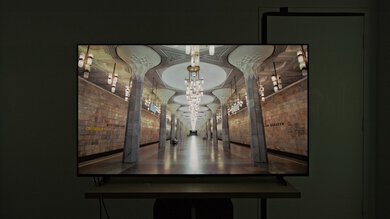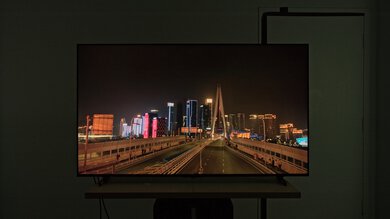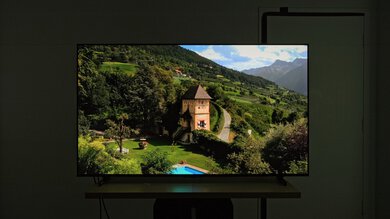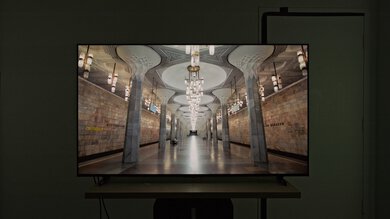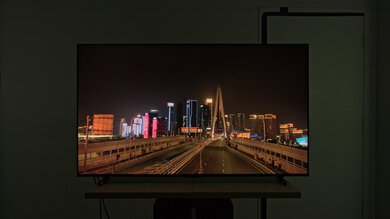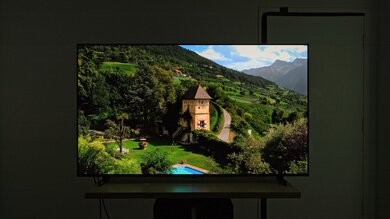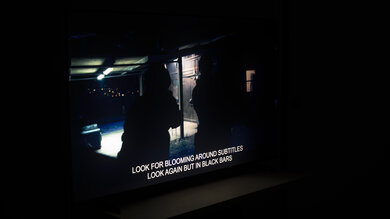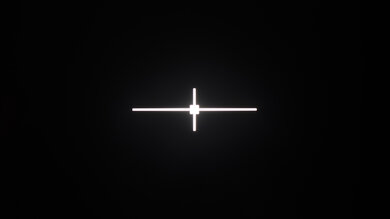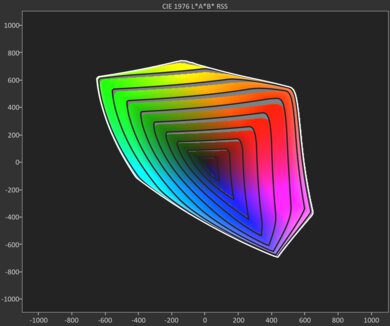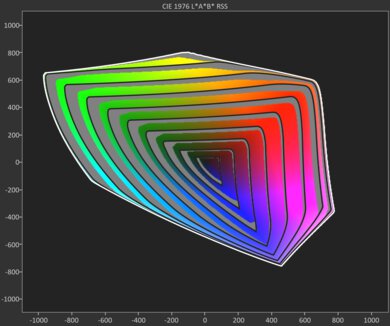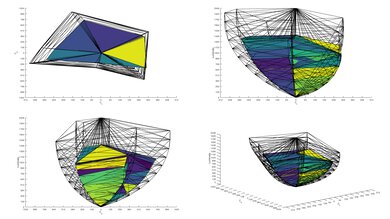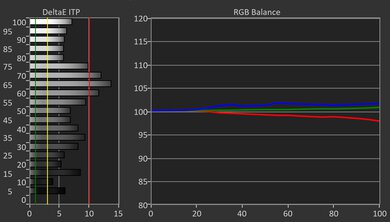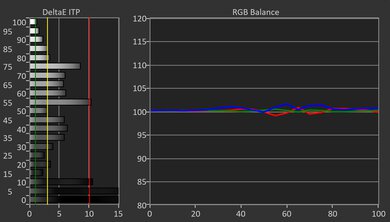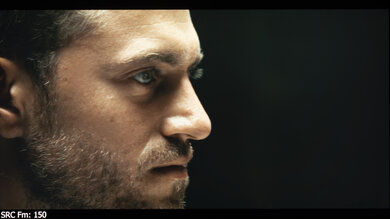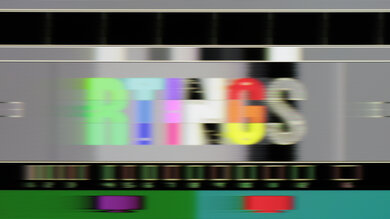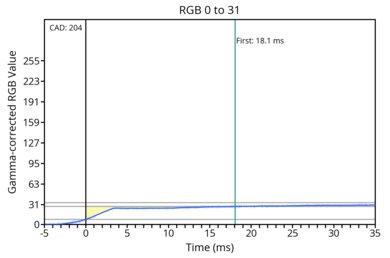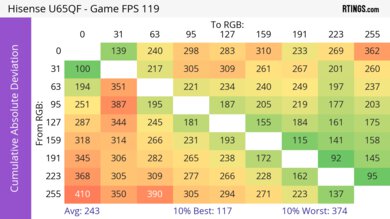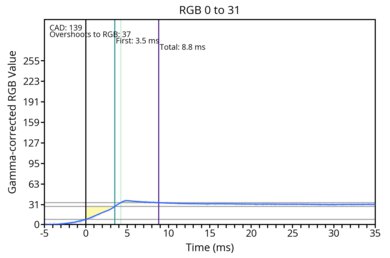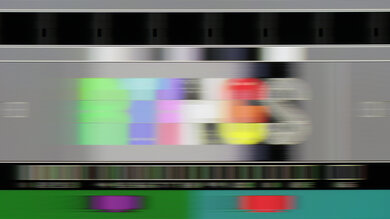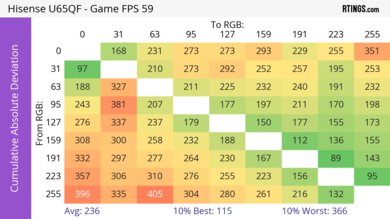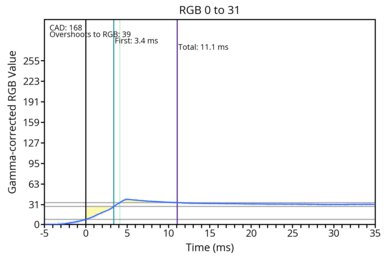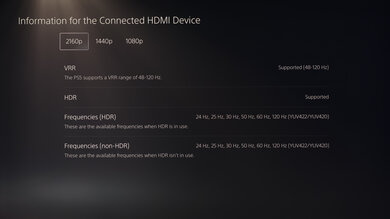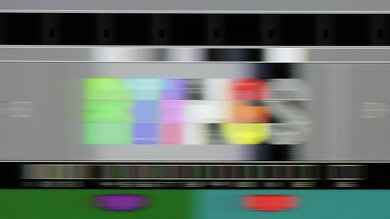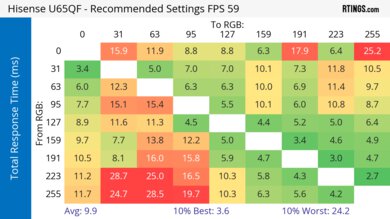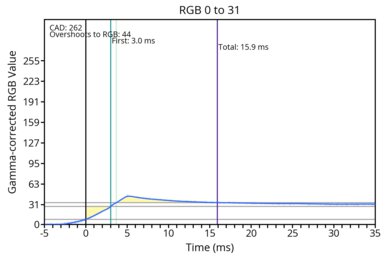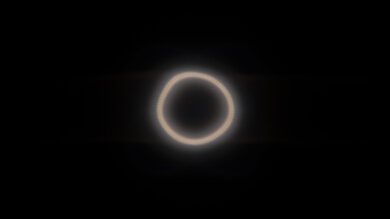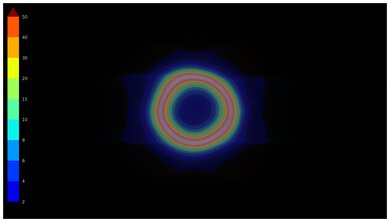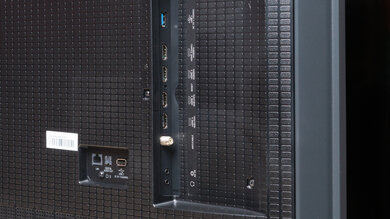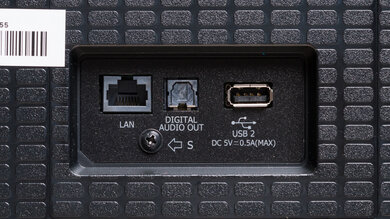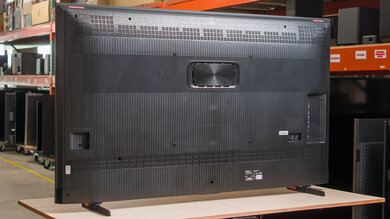The Hisense U65QF is a budget model in Hisense's ULED lineup and sits below the Hisense U75QG and Hisense U8QG. Like the Hisense U6N from 2024, it's one of the most affordable Mini LED TVs with local dimming. This 2025 model brings some improvements over its predecessor, such as the inclusion of HDMI 2.1 bandwidth on two ports for up to 4k @ 144Hz with VRR. It also supports Dolby Vision, HDR10+, and DTS audio passthrough, so it's packed with a ton of features. Unlike the higher-end models in the Hisense ULED lineup, which utilize the Google TV OS, this model runs the less popular Fire TV. It's still loaded with popular streaming applications and has smart features like voice control. We bought and tested the 65-inch model, but it's also available in 55, 75, 85, and 100-inch options.
Our Verdict
The Hisense U65QF is decent for a variety of usages. In a dark room, you get deep blacks, vibrant colors, and adequate HDR brightness, although it's not very accurate in HDR. When you flick your lights on, the TV has the SDR brightness needed to overcome glare, as long as you don't have any light sources directly facing the screen. The TV is loaded with modern gaming features, so it's a good addition to your modern gaming console, but faster motion is a bit blurry. The TV's viewing angle is alright, but the TV isn't suitable for wide seating arrangements.
Great SDR brightness in all scenes.
Blacks remain deep and colors stay vibrant in a room with ambient lighting.
Good contrast for deep blacks.
Poor handling of direct reflections.
Very slow when adjusting the TV's backlight setting.
The Hisense U65QF is decent for a home theater. It has good contrast, so it displays deep blacks. However, blacks look a bit uneven during dark scenes due to the TV's mediocre black uniformity, and there's visible blooming around highlights and subtitles. Still, when combined with its adequate HDR brightness and good color vibrancy, you get a pleasing image in a dark room. Even though the TV has decent color accuracy in HDR and SDR, the entire image is over-brightened in HDR, so it doesn't fully respect the content creator's intent.
Accurate colors in SDR out of the box.
Blacks remain deep and colors stay vibrant in a room with ambient lighting.
Good contrast for deep blacks.
Good low-quality content smoothing and upscaling capabilities.
Poor PQ EOTF tracking means the TV over brightens HDR content.
Mediocre black uniformity affects the deepness of blacks in dark scenes.
The Hisense U65QF is good for use in a bright room. It has great SDR brightness, so it overcomes glare from indirect light sources. You still enjoy solid image quality in a bright room, since the TV mostly retains its deep blacks and vibrant colors, so the TV looks almost as good as it does in a dark room. Unfortunately, its direct reflection handling is inadequate, so any light sources facing the screen are reflected like a mirror.
Great SDR brightness in all scenes.
Accurate colors in SDR out of the box.
Poor handling of direct reflections.
The Hisense U65QF is good for watching sports. The TV has great SDR brightness, helping it overcome glare from indirect lighting. Unfortunately, it has poor handling of direct reflections, so it's best to set up the TV in a spot where there are no light sources facing the screen. The playing field and the colors of jerseys are nice and vibrant, so you get a pleasing image. The TV even has good upscaling and low-quality content smoothing capabilities, so it does a good job of showing a clean and sharp enough image when you're watching the game on compressed cable feeds. Its viewing angle is alright, so your friends can watch the game from a slight angle and see a mostly consistent image.
Great SDR brightness in all scenes.
Accurate colors in SDR out of the box.
Good low-quality content smoothing and upscaling capabilities.
Poor handling of direct reflections.
The Hisense U65QF is decent for gaming. It has HDMI 2.1 bandwidth for up to 4k @ 144Hz with VRR, making it fully compatible with modern consoles. Fast motion is a bit blurry due to the TV's okay pixel transitions, but its low input lag means you get a snappy gaming experience. The TV displays vibrant colors, deep blacks, and adequate HDR brightness, so most games look pretty good.
Good contrast for deep blacks.
Very low input lag.
HDMI 2.1 bandwidth, 4k @ 144Hz, and VRR.
Pixel transitions are slower at 144Hz than lower refresh rates, leading to more motion blur.
The Hisense U65QF has decent brightness overall. It has great SDR brightness, no matter the content, so it easily overcomes glare from indirect lighting. It's not as bright in HDR, but highlights still stand out well enough for an adequate HDR experience.
Great SDR brightness in all scenes.
The Hisense U65QF has decent black levels. The TV has good contrast, so blacks are deep, but there's noticeable blooming around highlights and subtitles in darker scenes. Unfortunately, the TV's mediocre black uniformity means blacks aren't consistent across the screen, so there are uneven areas of brightness during purely dark scenes.
Blacks remain deep and colors stay vibrant in a room with ambient lighting.
Good contrast for deep blacks.
Mediocre black uniformity affects the deepness of blacks in dark scenes.
The Hisense U65QF has decent color vibrancy in SDR and HDR, so colors stand out well in most content. Colors have great accuracy in SDR, but less so in HDR, so color enthusiasts will likely want to get the TV calibrated.
Accurate colors in SDR out of the box.
Note: We're in the process of improving our tests related to image processing, but this score should give you a general idea of how a TV performs overall with its image processing capabilities.
The Hisense U65QF has okay processing capabilities overall. It does a good job upscaling low-resolution content and cleaning up artifacts in low-bitrate content, so you don't have to watch a soft and noisy image when the quality of your content isn't ideal. There's some noticeable banding in color gradients, but gradients are smooth enough overall that you aren't too distracted by this. Unfortunately, the TV has poor PQ EOTF tracking, and almost the entire image is brighter than intended in HDR, meaning this model doesn't truly respect the filmmaker's intent.
Good low-quality content smoothing and upscaling capabilities.
Poor PQ EOTF tracking means the TV over brightens HDR content.
The Hisense U65QF has good responsiveness while using its dedicated gaming mode. It has two HDMI 2.1 bandwidth ports capable of 4k @ 144Hz with VRR, and it has low input lag for a responsive feel. The TV's pixel transitions are a bit slow, leading to some motion blur when the action ramps up, but slower titles look mostly smooth.
Very low input lag.
HDMI 2.1 bandwidth, 4k @ 144Hz, and VRR.
Pixel transitions are slower at 144Hz than lower refresh rates, leading to more motion blur.
We're in the process of fixing the way we evaluate a TV's overall motion handling. This section is currently broken, and the score isn't indicative of how well a TV handles motion overall.
Performance Usages
Changelog
-
Updated Sep 09, 2025:
We bought and tested the Hisense QD7QF, and added a comparison in the HDR Brightness section.
-
Updated Jun 26, 2025:
Mentioned the newly reviewed Samsung Q7F 2025 in the SDR Brightness section.
- Updated Jun 20, 2025: Review published.
- Updated Jun 17, 2025: Early access published.
Check Price
Differences Between Sizes And Variants
We bought and tested the 65-inch Hisense U65QF, and most of our results should also be valid for the 55-inch, 85-inch, and 100-inch models. The 75-inch uses an ADS Pro panel, so it performs differently from the other sizes, and our results aren't valid for it. All sizes of the TV are advertised as having a peak brightness of up to 1000 nits, but it's highly likely that the peak brightness is different depending on the size. In Canada, the TV is known as the Hisense U68QF and performs the same. There are similarly named international models, but these models perform differently from the North American model, so our results aren't valid for them.
| Size | US Model | Panel Type | Advertised Dimming Zones |
|---|---|---|---|
| 55" | Hisense 55U65QF | VA | 160 |
| 65" | Hisense 65U65QF | VA | 300 (Confirmed) |
| 75" | Hisense 75U65QF | ADS Pro | 320 |
| 85" | Hisense 85U65QF | VA | 576 |
| 100" | Hisense 100U65QF | VA | 608 |
Our unit was manufactured in February 2025.
Popular TV Comparisons
The Hisense U65QF is a decent TV when compared to higher-end models, but it's surprisingly good for a budget model. It's one of the cheapest TVs on the market with HDMI 2.1 bandwidth and 4k @ 144Hz, so it's a good choice for gamers on a budget. It provides solid picture quality too, with good contrast, colors, and overall brightness. Unfortunately, it has poor PQ EOTF tracking that overbrightens the entire image, which is a drawback for those who care about the filmmaker's intent in HDR. It competes most with the similar TCL QM6K, but that TV has superior contrast, better PQ EOTF tracking, and less stutter, making it the better option for a home theater. However, the U65QF is the brighter TV and has the edge with image quality in a well-lit room, making it more suitable for bright rooms. If you're looking for an affordable model that punches above its weight class, the U65QF is a very solid option.
For more options, check out our recommendations for the best Mini LED TVs, the best QLED TVs, and the best gaming TVs.
The Hisense U75QG is significantly better than the Hisense U65QF. The U75QG is significantly brighter in HDR, resulting in brighter specular highlights and a more impactful HDR experience overall. It also has a better local dimming feature, which helps it deliver deeper blacks with less haloing around bright highlights or subtitles.
The TCL QM6K and the Hisense U65QF are similar overall, but there are some differences. The Hisense is the brighter TV, so highlights stand out a bit more in HDR content, and it overcomes more glare in a well-lit room. On the other hand, the TCL has better black levels and is a lot more accurate in HDR, making it the better option for home theaters. The TCL also supports 1080p @ 288Hz, has a more consistent VRR feature, and has slightly faster pixel transitions, making it a bit better for gamers.
The Hisense U65QF is a better TV than the Hisense QD7N. The U65QF has significantly better black levels due to its local dimming feature, giving the image more depth. The U65QF is also more suitable for bright rooms thanks to its superior SDR brightness, and its 144Hz supports makes it a better option for PC gamers.
The Hisense U8QG is significantly better than the Hisense U65QF. The U8QG delivers a far more impactful HDR experience thanks to its higher peak brightness, better color volume, and wider color gamut. The U8QG also has a much better local dimming feature, so blacks are deeper and more uniform in dark scenes, and bright highlights stand out better against a dark background, with less haloing.

We buy and test dozens of TVs yearly, taking an objective, data-driven approach to deliver results you can trust. Our testing process is complex, with hundreds of individual tests that take over a week to complete. Most of our tests are done with specially designed test patterns that mimic real content, but we also use the same sources you have at home to ensure our results match the real-world experience. We use two main tools for our testing: a Colorimetry Research CR-100 colorimeter and a CR-250 spectroradiometer.
Test Results

The Hisense U65QF has adequate HDR brightness, and it's noticeably brighter than the entry-level Hisense QD7QF. Combined with the TV's good contrast, highlights get bright enough to stand out in dim and moderately lit scenes. Entirely well-lit scenes aren't quite as bright, but those scenes don't look too dim, and you don't notice a large drop in luminance.
Our results above are with the TV set to Movie Mode with 'Dynamic Contrast' disabled. Below are the results with 'Dynamic Contrast' turned on, which gives you a slightly brighter image at the cost of accuracy.
- Hallway Lights: 465 cd/m²
- Yellow Skyscraper: 330 cd/m²
- Landscape Pool: 295 cd/m²
There's no visible difference in HDR brightness when using Game Mode, so you don't have to worry about trading in brightness for performance. Unlike Movie Mode, you can't enable the 'Dynamic Contrast' setting while using the TV's dedicated gaming mode.
The Hisense U65QF has great SDR brightness. Smaller areas of brightness have higher luminance than entirely well-lit scenes, but the TV is bright enough during all scenes to overcome glare from indirect lighting. This TV is much brighter than competing models like the Samsung Q7F 2025.
The TV has mediocre lighting zone transitions, which is noticeable with fast-moving content. There's visible haloing, the front and back edges of bright objects are dimmer as they move across the screen, and bright objects show a flicker-type effect when they move very quickly.
The TV has decent SDR color volume. Like almost any TV, it covers the full range of colors in the BT.709 color space, but it also has very good coverage of the wider DCI-P3 color space. It has mediocre coverage of the widest BT.2020 color space, as its color volume isn't good enough to display most colors.
| Volume ΔE³ | DCI-P3 Coverage |
BT.2020 Coverage |
|---|---|---|
| L10 | 93.33% | 68.14% |
| L20 | 93.31% | 67.62% |
| L30 | 91.88% | 66.41% |
| L40 | 89.92% | 66.66% |
| L50 | 88.12% | 66.28% |
| L60 | 86.98% | 64.26% |
| L70 | 86.79% | 56.61% |
| L80 | 86.53% | 54.11% |
| L90 | 86.71% | 54.24% |
| L100 | 87.02% | 60.35% |
| Total | 87.96% | 60.87% |
The Hisense U65QF has decent HDR color volume. Most dark, saturated colors are displayed well, but it struggles a bit with bright whites and most bright colors. It's still good enough for a vibrant viewing experience, but very bright colors don't pop off the screen as much as they do on this TV's higher-end sibling, the Hisense U75QG.
The Hisense U65QF has great SDR pre-calibration accuracy. Gamma is pretty close to 2.2, but most scenes are displayed darker than intended. Its white balance is outstanding, but reds are a bit underrepresented in most grays, which contributes to the TV's overly cool color temperature. Still, colors have great accuracy overall, with only minor errors that most people won't notice. This TV gives you a mostly accurate image out of the box.
The TV has outstanding SDR color accuracy after calibration. Any inaccuracies with white balance, color temperature, and gamma are essentially gone. Colors have amazing accuracy overall, with only minor inaccuracies in well-saturated reds that most people won't notice.
See our full calibration settings.
The Hisense U65QF has decent HDR accuracy before calibration. Blues are overrepresented in most shades of gray while reds are underrepresented, which makes the TV's color temperature a lot cooler than the industry standard 6500K. Colors still have good accuracy overall, but warmer colors have mapping errors and are undersaturated.
Although Filmmaker Mode is usually the best option for an accurate image out of the box, Movie Mode is actually the most accurate HDR setting on this TV. For comparison, take a look at our results using FMM.
The TV has very good HDR accuracy after calibration. White balance and overall color accuracy has improved, and although the TV's color temperature is now closer to 6500K, it's still noticeably too cool. Calibrating the TV doesn't make a massive difference in HDR color accuracy, but color enthusiasts will likely want to get it calibrated for the most accurate image possible from this model.
The Hisense U65QF has poor PQ EOTF tracking. Almost everything is displayed drastically brighter than intended, so this isn't a TV that stays true to the content creator's intent in HDR. The TV tracks the PQ EOTF curve much closer with a standardized 10% window, but this isn't indicative of real-world usage, since highlights in HDR content don't take up exactly 10% of the screen. There's a gradual roll-off near the TV's peak brightness when displaying 4000 nit content to help maintain details in specular highlights.
The TV has satisfactory HDR gradient handling. There's noticeable banding in greens, dark grays, dark reds, and dark blues, and but other color gradients have minimal banding.
The Hisense U65QG has low input lag overall. At the TV's maximum refresh rate of 144Hz, the input lag is very low, which is great for gamers who primarily play PVP titles. You also still get low input lag at 60Hz and 120Hz, so you get a responsive gaming experience at all refresh rates.
The Hisense U65QF supports all common resolutions up to 4k @ 144Hz, and it supports chroma 4:4:4, so it has great compatibility with gaming consoles and PCs.
The TV supports FreeSync, HDMI Forum VRR, and is G-SYNC compatible, ensuring a nearly tear-free gaming experience from any VRR-enabled source. It works well across the TV's entire refresh rate range and supports sources with Low-Frame-Compensation (LFC), which ensures your games remain nearly tear-free even when your frame rate drops very low.
Unfortunately, like many other Hisense TVs, it has a response time issue with VRR enabled. There are different overdrive settings above and below 71Hz, so you see inconsistent behavior when your frame rate hovers around 71 fps.
The Hisense U65QF has mediocre pixel transitions at its maximum refresh rate of 144Hz. Transitions to and from near-blacks are the slowest, so you see some black smearing during dark scene transitions. There's noticeable blur behind all fast motion, but it's not too bad for an LED model.
The TV has okay pixel transitions at 120Hz. It's better than at 144Hz, but transitions are still somewhat slow across the board, which leads to fast motion looking blurry, although it's usable. You still see black smearing when transitioning from black states.
The TV is fully compatible with everything the PS5 offers, like 1440p @ 120Hz and 4k @ 120Hz, as well as HDMI Forum VRR. It also supports Auto Low Latency Mode, so you don't have to worry about manually switching to Game Mode to get the lowest input lag.
The TV is fully compatible with everything the Xbox Series X|S offers, including 4k @ 120Hz, HDMI Forum VRR, FreeSync Premium Pro, and Dolby Vision gaming. It also supports Auto Low Latency Mode, so you don't have to worry about manually switching to Game Mode to get the lowest input lag. 1440p @ 120Hz only works if you force the resolution in the override settings, and doing that locks you out of using VRR.
Due to the TV's quick response time, there's some minor stutter when watching movies or shows that's most apparent in slow panning shots, but it's not too bad and not everyone will notice it.
The TV automatically removes judder from 24Hz sources. To remove judder from 60p/60i sources, 'Motion Processing' must be set to 'Film.'
The TV doesn't have an optional backlight strobing feature, commonly known as black frame insertion (BFI), to help reduce persistence blur.
This TV has an optional motion interpolation feature to improve the clarity of motion, but it doesn't work very well. Even slower-moving scenes have some noticeable artifacts present. In faster-moving scenes, it really struggles, and there are distracting artifacts and haloing. Although the TV's motion interpolation leaves a lot to be desired, you can lightly use the setting to mitigate some stutter if you're bothered by it.
The Hisense U65QF has inadequate direct reflection handling. Direct light sources like a lamp or window opposite your screen are very noticeable since the TV barely reduces the intensity of those reflections.
There's only some minor black level raise in a room with ambient lighting, so you still get deep blacks with your lights turned on.
The TV's perceived color volume in a bright room is good. Colors barely lose any saturation when they're exposed to light, so you still get punchy colors in a well-lit room.
The TV has an alright viewing angle. The image looks mostly consistent from a slight angle, but there's gamma shifting, black level raise, brightness loss, and color washout that worsens the further you move off-center. Since image quality is noticeably degraded at an aggressive angle, the TV isn't a very good choice for wide seating arrangements.
The Hisense U65QF has okay gray uniformity. There's some visible dirty screen effect towards the middle of the screen, and the corners of the screen are dimmer than the rest of the image. On a near-black screen, there are brighter splotches around the panel, leading to some parts being a bit brighter than the rest.
This TV uses a BGR subpixel layout. It doesn't affect picture quality but can cause issues with text clarity in some applications when using it as a PC monitor.
It uses a KSF phosphor coating to produce red light and has high peaks on reds and blues. This model does have good separation between colors, giving it solid color purity and a wide color gamut.
HDMI ports 3 and 4 support the full 48Gbps bandwidth of HDMI 2.1, while HDMI 1 and 2 are limited to HDMI 2.0 bandwidth. HDMI 1 is the eARC port, which is great if you have a soundbar and multiple consoles that you want to plug into the TV. However, this isn't good for those with an HDMI 2.1 capable receiver who need a full bandwidth HDMI port that is also the eARC port.
This TV supports eARC, which allows you to pass high-quality, uncompressed audio to a compatible receiver through an HDMI cable. It supports all major audio formats, so you don't have to worry about compatibility with external sources.
The two feet are made of plastic, but unlike similar TVs like the TCL QM6K, they can't be adjusted. The footprint of the 65-inch stand is 44" x 11.7".
The feet only lift the TV about 2.17 inches, so thicker soundbars do block the bottom portion of the screen.
The back is made of plastic and has a grid-like pattern that resembles a lot of Sony TVs. All of the inputs are side-facing, but they're in a recessed cutout that makes them a bit hard to access if you have it mounted to a wall. Unfortunately, there's no clips or grooves to help with cable management.
The TV has an okay frequency response. There's barely any meaningful bass, but the sound profile is balanced enough for dialogue to be clear at moderate volume levels. With the TV at maximum volume, the sound profile loses balance. This makes dialogue harder to understand, especially during action scenes.
